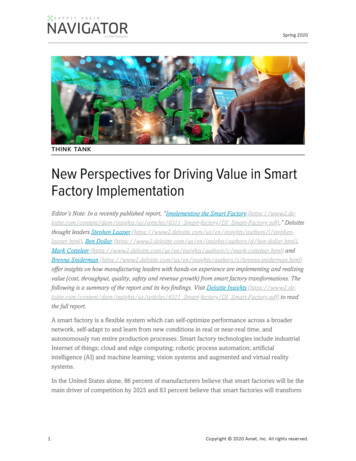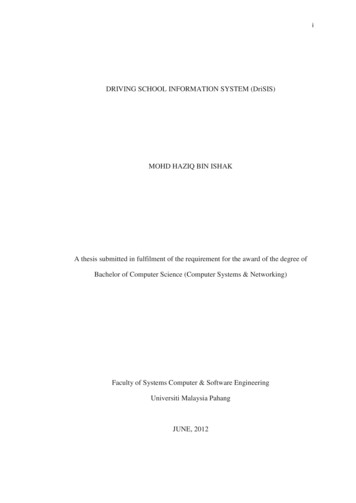
Transcription
Spring 2020THINK TANKNew Perspectives for Driving Value in SmartFactory ImplementationEditor’s Note: In a recently published report, “Implementing the Smart Factory /articles/6311 Smart-factory/DI Smart-Factory.pdf),” Deloittethought leaders Stephen Laaper l/stephenlaaper.html), Ben Dollar d/ben-dollar.html),Mark Cotteleer c/mark-cotteleer.html) andBrenna Sniderman s/brenna-sniderman.html)offer insights on how manufacturing leaders with hands-on experience are implementing and realizingvalue (cost, throughput, quality, safety and revenue growth) from smart factory transformations. Thefollowing is a summary of the report and its key findings. Visit Deloitte Insights /articles/6311 Smart-factory/DI Smart-Factory.pdf) to readthe full report.A smart factory is a flexible system which can self-optimize performance across a broadernetwork, self-adapt to and learn from new conditions in real or near-real time, andautonomously run entire production processes. Smart factory technologies include industrialInternet of things; cloud and edge computing; robotic process automation; artificialintelligence (AI) and machine learning; vision systems and augmented and virtual realitysystems.In the United States alone, 86 percent of manufacturers believe that smart factories will be themain driver of competition by 2025 and 83 percent believe that smart factories will transform1Copyright 2020 Avnet, Inc. All rights reserved.
Spring 2020the way products are made. Yet only five percent of U.S. manufacturers surveyed in 2019reported full conversion of at least one factory to “smart” status, and nearly two out of three(65 percent) manufacturers surveyed report no progress on initiatives to adopt smart factorytechnologies.Today’s leaders have a broad range of choices and opportunities with respect to smart factorytransformations, both in terms of which technologies to use, and how to deploy them.Considering lessons from those who have implemented a smart factory can providemanufacturers with direction forward and help pave the way to greater value realization. As inany transformation effort, culture and change management are key considerations [seeUnderlying Change Management Themes], but there are other factors that are more unique tothe smart factory and its technologies. Below is an outline of the “smart factory-specific”lessons learned across the different deployments of our study participants, as well as howleaders can translate these lessons into value for their factories and their broaderorganizations.1) Smart Factory Lessons Learned2Copyright 2020 Avnet, Inc. All rights reserved.
Spring 2020 Criticality of ConnectivitySmart factory and its resulting value generally hinge on the ability to connect assets,processes, people, and devices. The issue of connectivity arose in nearly every smartfactory deployment that Deloitte studied; in many facilities, Wi-Fi and cellularconnectivity are often irregular in the labyrinth of steel and concrete. Connectivity wasalso identified as a top challenge for smart factory adopters in broader research: Thirtythree percent of smart factory leaders in the recent Deloitte-MAPI survey identified lackof necessary IT infrastructure as a significant impediment to smart factory initiatives. Ifan application or process can’t connect to the network to share and access information, itwill fail no matter how well thought out it is. The Need for a Flexible Approach to AssetsThe variety of machinery, sensors, and other devices that exist on the shop floor mustalso be considered. Even within the same plant network, each facility is likely unique interms of layout, equipment, and product. Smart factory practitioners identified multipledimensions to this challenge, including: Diversity in machine age: Smart factory deployments span some of the newest,most advanced manufacturing technologies in the world—as well as some of theoldest. Integrating across these age groups can be difficult, but it can allowleaders to access data about processes and functions that were previouslyimpossible to get Diversity in purpose: In some cases, new real-world applications of devicesprovide teams with the chance to innovate, discover new ways to capture data,and find new opportunities for value. Diversity in data structure and format: In a smart factory, data comes from manysensors and devices and takes many formats. Cleansing and mapping efforts areoften crucial to ensuring that data from one system or device can be combinedand leveraged with data from another. Diversity in access methods: Adding sensors to all equipment is not alwayspractical; issues with access, quality, security, or machine uptime may intervene.Teams may need to leverage technology to develop alternative means formeasurement and data collection. For example, one interviewee explained howprocess control on older, analog machines was accomplished via digital cameras,AI, and vision systems to “read” gauges and capture data.3Copyright 2020 Avnet, Inc. All rights reserved.
Spring 2020 Bridging the Divide Between IT and OTAchieving balance among competing priorities of IT and operational technology teamscan be challenging. IT organizations are focused on securing technology assets andmaintaining system integrity, while OT are suddenly pushing to jump the firewall andenable access to these assets to outside entities. Be prepared for conflicts over dataaccess and rights, IT development rights, and shifts in technology approach. Respectingthe different professional cultures can help your teams find the sweet spot betweenconnectivity and index.html)2) Turning Lessons into Outcomes4Copyright 2020 Avnet, Inc. All rights reserved.
Spring 2020 Illuminating the Hidden FactoryThe infusion of connected assets and new flows of data enables organizations to seethings that were always there, but previously impossible to observe or quantify. Inaddition, rapid increases in processing power have led to new analytics capabilities andthe ability to generate ever-deeper insights, virtually impossible to produce even severalyears ago. For example, using predictive capabilities driven by advanced shop-flooranalytics a manufacturer more than doubled production on existing capital equipment.With the right architecture in place, data can be shared across the connected ecosystemto inform fulfillment, product development, planning, supply, and customer service. Leverage Current Systems for New ValueInterview subjects acknowledge the complexity and difficulty of connecting the range ofsystems and assets and stressed the need to be flexible in their approach to diversedevices, data, and systems. By integrating their current systems digitally and leveragingthe data, companies can optimize operations, drive greater productivity, and leveragetalent. For example, the marriage of lean manufacturing with smart factory principlesextends existing lean capabilities providing more accurate, precise, and timelyinformation about operations and resulting in a better ability to monitor production andreport issues, among other capabilities. The smart factory can also enable smarterallocation of workforce. Data can indicate where maintenance crew, machine operators,and others need to be to optimize performance, and power persona-based tools thatfocus efforts on insights relevant to specific roles. Further, workers can team with digitaland physical technologies to augment their capabilities, while the technology itself mayalso create wholly new roles within the smart factory. Harness AI and Other Advanced Tools to Get to the Next LevelAdvanced analytics, powered by AI, enable smart factory operators to comprehendinformation from their newly illuminated processes, and handle data loads as well ascritical, previously unknown correlations in the data that a human, at scale, cannot.Leaders reported double-digit percentage improvements in production processes,machine utilization, and throughput from the deployment of AI-driven capabilities,including:5Copyright 2020 Avnet, Inc. All rights reserved.
Spring 2020 Predictive maintenance Dynamic routing of inputs and other materials throughout the facility Analyzing, sensing, and proactively responding to circumstances across the smartfactor in a control tower Monitoring and optimizing performance of products or processes through thedeployment of digital twins and digital threads Scaling Throughout Ecosystems and Digital Supply NetworksThe influx of data and information can drive improved operations not just in one facility,but throughout the network and even the broader ecosystem. After piloting connectedfactory technologies in discrete locations, organizations recognize exponential value byscaling solutions beyond their four walls. For example, a consumer productsmanufacturer reported double-digit returns on an investment in advanced analytics andAI to optimize purchasing of production inputs across its manufacturing network.Deloitte’s research clearly demonstrates that manufacturers broadly agree that the future ofmanufacturing is “smart,” and the empirical results we have seen as a part of this study clearlylink to significant value delivery. Though there may be no single approach to successful smartfactory deployment, we hope the insights from our research may help companies getthemselves started on the path to realizing the vision and value of a smart factory future.Comments or questions, click here (mailto:mcotteleer@deloitte.com?subject SCN%20Smart%20Factory%20Article%20Inquiry) to contact Implementing the SmartFactory /articles/6311 Smartfactory/DI Smart-Factory.pdf)” authors.Related Resources:Network: (https://www.mapi.net/) Manufacturers Alliance for Productivity and Innovation(MAPI)Portal: solutions/the-smart-factory.html?id yAIQd:1170071657:407419340317:e:Internet of Things:Smart Factory Services Exact:nb) Deloitte Smart Factory ServicesImmersive Experience: resources/so-6Copyright 2020 Avnet, Inc. All rights reserved.
Spring id yAIQd:1170071657:407419340308:e:Internet of Things:Smart Factory Services Exact:nb) The Smart Factory @ WichitaArticle: value-first/) Smart Factory: ValueFirstFACEBOOK7LINKEDINTWITTERSHARE ARTICLECopyright 2020 Avnet, Inc. All rights reserved.
THINK TANK New Perspectives for Driving Value in Smart Factory Implementation Editor's Note: In a recently published report, "Implementing the Smart Factory (https://www2.de-










